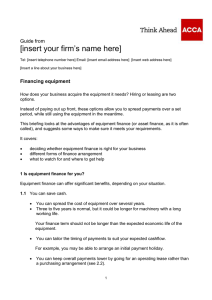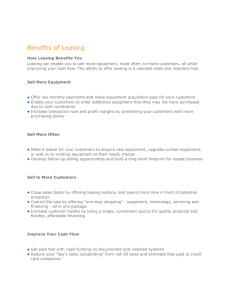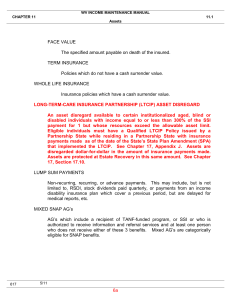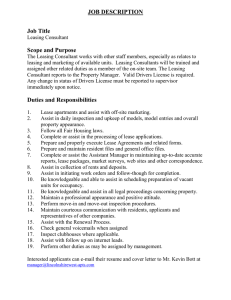Name of ACCA member organisation here Factsheet from
advertisement
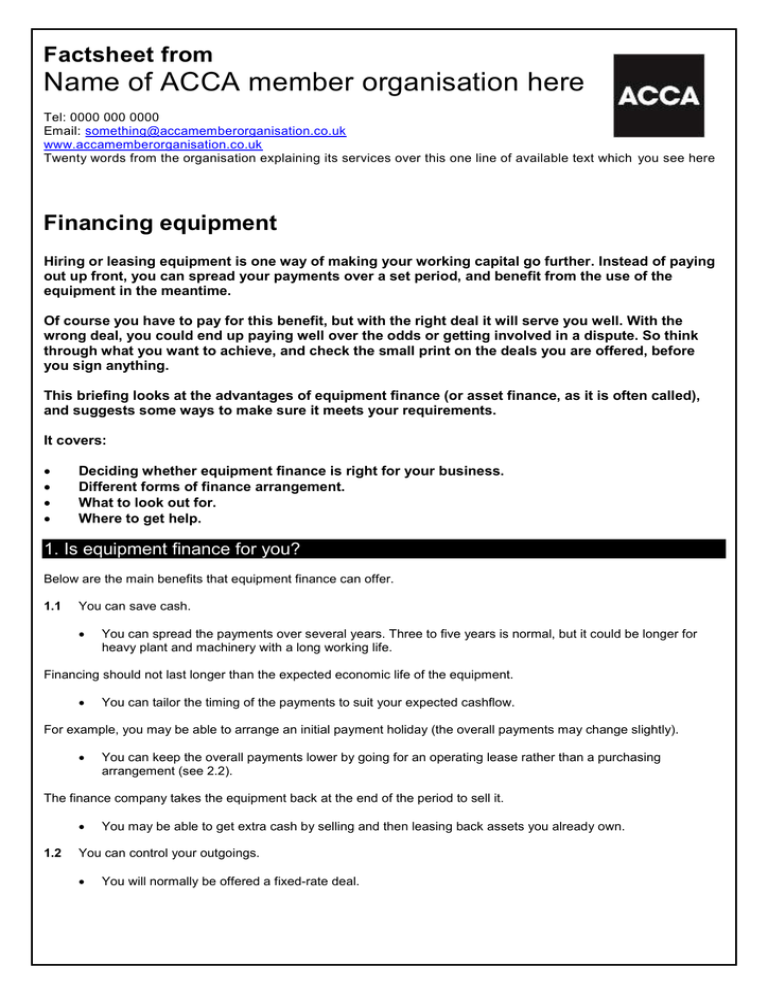
Factsheet from Name of ACCA member organisation here Tel: 0000 000 0000 Email: something@accamemberorganisation.co.uk www.accamemberorganisation.co.uk Twenty words from the organisation explaining its services over this one line of available text which you see here Financing equipment Hiring or leasing equipment is one way of making your working capital go further. Instead of paying out up front, you can spread your payments over a set period, and benefit from the use of the equipment in the meantime. Of course you have to pay for this benefit, but with the right deal it will serve you well. With the wrong deal, you could end up paying well over the odds or getting involved in a dispute. So think through what you want to achieve, and check the small print on the deals you are offered, before you sign anything. This briefing looks at the advantages of equipment finance (or asset finance, as it is often called), and suggests some ways to make sure it meets your requirements. It covers: Deciding whether equipment finance is right for your business. Different forms of finance arrangement. What to look out for. Where to get help. 1. Is equipment finance for you? Below are the main benefits that equipment finance can offer. 1.1 You can save cash. You can spread the payments over several years. Three to five years is normal, but it could be longer for heavy plant and machinery with a long working life. Financing should not last longer than the expected economic life of the equipment. You can tailor the timing of the payments to suit your expected cashflow. For example, you may be able to arrange an initial payment holiday (the overall payments may change slightly). You can keep the overall payments lower by going for an operating lease rather than a purchasing arrangement (see 2.2). The finance company takes the equipment back at the end of the period to sell it. 1.2 You may be able to get extra cash by selling and then leasing back assets you already own. You can control your outgoings. You will normally be offered a fixed-rate deal. You will know what your payments are going to be, right from the start (assuming no change in tax rates or allowances). Provided you honour the terms and conditions, the finance will be secure for the term of the agreement. The leasing company cannot bring the arrangement to a premature end. You may be able to end it early, although there will probably be a charge. Read the small print. 1.3 You need offer no extra security. The equipment itself is normally the only security on a finance agreement. If you borrowed from your bank to buy the equipment instead, you would normally have to provide extra security. Finance arrangements must normally be shown on your balance sheet. This increases your gearing (the ratio of borrowings to equity), so it may affect your ability to borrow. The main exception is operating leases (see 2 and see box). 1.4 You can easily replace the equipment at the end of the agreement. 1.5 With some financing arrangements you never own the asset, just have use of it while the agreement lasts. If the equipment is likely to be worn out or outdated by the end of the agreement, this arrangement could suit you. The finance company must get rid of the old equipment. You can move on to new equipment. You may be able to replace the asset before the end of the financing term, although there will be a cost. Check carefully if you are carrying forward any liability. It may pay you to settle in full (for example, if interest rates have risen). If appropriate, you can arrange a service contract at the same time as the finance deal. This could be a good option if the equipment needs continuous servicing support (eg a server unit). If service is included, it must be shown on the agreement. If it is not shown, do not sign.. Take care before signing any service-inclusive deal. There could be too much scope for confusion about the charges. You should be able to get a deal with payments directly related to use, and all service and maintenance elements (except accidental damage) included. Check whether — and to what extent — consumables are included. If you pay charges based on metered use, take readings before and after the engineer calls, and insist that test use is credited back to you. 2. Types of contract If equipment finance might make sense in your circumstances, you need to decide on the type of contract. 2.1 If you want to own the asset at the end of the agreement, go for a hire purchase (sometimes called a lease purchase) arrangement. A purchase arrangement makes sense when the asset would be worth more to you than the finance company could make by selling it second-hand. For example, PCs lose value fast, because new models with improved technology are introduced. But if you do not need machines with greater abilities, it might pay you to keep your existing PCs going. 2 Negotiate the payment arrangements you want. You might want payments spread evenly over the term of the agreement. Or you might want lower regular payments, but a bigger final payment (a ‘balloon’ payment). This will only be available on equipment with reliable secondhand value. You could hedge your bets by going for lower payments, and making a decision on selling or keeping the equipment nearer the end of the contract. But you will have to meet the ‘balloon’ payment in full, whether or not you decide to sell, and whatever the equipment is worth by then. The asset remains the property of the finance company until the final payment is made. You are responsible for insurance and maintenance, and must not let the equipment out of your possession. 2.2 If you do not want to own the asset at the end of the period, go for a lease instead. With a finance lease, the asset is sold to a third party at the end of the agreement, and you receive most of the proceeds as an agreed rebate. Alternatively, you may be able to extend the agreement for another term, at a much lower cost. For example, the quarterly payment on the first agreement might become the annual payment on the second. With an operating lease, you make lower payments in total but do not normally share in the proceeds when the equipment is eventually sold. Many finance companies offer operating leases only on assets which are easy to sell (eg cars). Provided that an operating lease fulfils the requirements of the 90 per cent rule (see box), it may not need to be shown on your balance sheet. As with hire purchasing, you are responsible for maintenance and insurance. 3. The tax position The tax position depends partly on whether the deal will eventually give you ownership of the equipment, and partly on your own tax position. 3.1 If you are going for a purchase agreement: 3.2 You can claim capital allowances. You can offset the interest element of the payment against your taxable profits. If you are VAT registered, you can generally reclaim the VAT on the capital cost of the asset. If you are going for a lease agreement: You cannot claim capital allowances. You can offset the rental payments against your taxable profits. You can reclaim the VAT on rentals (if you are VAT registered). Special rules apply to cars. 4. Which deal? Only when you have decided that you want equipment finance, and have some idea of the kind of contract you would like, should you start looking at particular deals. Doing it the other way round can prove expensive. Although many finance companies — and the dealers they do business with — are highly respectable, some cowboys still operate in this area. If you fall into their hands, you could find yourself legally committed to paying well over the odds for years to come. So be careful. 3 4.1 Go for quality. Make sure the finance companies you deal with are members of the Finance and Leasing Association (see 5.1). Members are subject to a (voluntary) code of practice. Choose a company which specialises in financing for businesses like your own. You can expect the equipment financing subsidiaries of the big banks to play strictly by the rules. They have to guard their parent companies’ reputations as well as their own. You may find it takes longer to get a decision out of them. Manufacturers’ own finance companies also have an interest in playing strictly by the rules, but their rates may be less competitive than most. Smaller banks and asset finance companies may be more flexible about advancing credit, but some of them might also be less picky about the dealers they do business with. Even if the dealer misrepresented some terms of the agreement, the finance company will hold you to the deal. 4.2 Obtain quotes. 4.3 Ask the right questions (see box) and get the answers in writing. Aim to get at least three comparable quotes before you make a decision. At least two should be from companies with a real reputation to lose (see 4.1). Check the figures and terms. Ask your accountants whether they have expertise in this area and, if so, get them to give you an opinion on the best deal. Your accountants can also confirm whether the finance should be shown on your balance sheet. 4.4 If you have a good solicitor, get him or her to look over the contract proposals, to help you find the best deal. Make sure the name of the leasing company is stated on the contract. If service is included it must be shown on the contract. If it is not shown, do not sign it. Check that there are no advanced or final payments hidden in the small print. Do not sign anything until you are satisfied. Unincorporated businesses (sole traders and partnerships) are entitled to some protection from unscrupulous deals, under the terms of the Consumer Credit Act. In general, the courts take a tough line with people who sign contracts without finding out what they are letting themselves in for. If you have committed yourself to paying too much, you could be held to the deal. 4.5 Be equally careful when it comes to renewals or upgrades. You are committed to holding the equipment for the finance company until the end of the arrangement. Before surrendering it for an upgrade or settlement, get the finance company to confirm the upgrade or settlement figure in writing. If service is included in the contract and the contract is upgraded there should be no settlement included for the service. Check the terms of any rollover or upgrade as carefully as you checked those of the initial deal. Make sure any settlement payments are paid direct to the other leasing company or to you, rather than through a dealer. If the dealer goes bust holding the money, you will still owe the finance company. 4 Do not let the dealer remove equipment without written agreement from the finance company that owns it (see 2.1). 5. Where to get help Equipment finance is a difficult area. You need advice, particularly if you are dealing with an unknown company or if you are considering a large purchase. Good advice in this area can be hard to find. 5.1 Ask the Finance and Leasing Association for an up-to-date list of members and a copy of their code of practice (020 7836 6511 or www.fla.org.uk). 5.2 Ask your accountants if they have a leasing expert or, if not, who they can recommend. 5.3 Try to find a specialist consultant on equipment finance. Questions to ask Are you buying (or leasing) new equipment? How do you know it is new? Is it written down anywhere? Does the serial number match up? What is the list price? What would the makers charge if you bought it direct? What is the delivery charge? What are the maintenance and servicing charges? Does the deal depend on your purchase of a certain amount of consumables? If so, what quantity? How many instalments do you have to pay throughout? How much are the instalments, and what do they cover? Are there any usage charges (eg excess mileage charges on cars)? When do they kick in? Are spare parts guaranteed for the life of the lease? What happens at the end of the term? Do you have to give notice to end the deal? Can you extend it if you want to? What happens if you cannot maintain your payments? What happens if the equipment does not work, or works inadequately? The 90 per cent rule Anything that you are purchasing (eg through hire purchase) must be entered on your balance sheet (see 1.3). If you are leasing or contract-hiring an asset, and the finance company or dealer holds a significant residual value at the end of the contract, the liability need not be shown on your balance sheet. The 90 per cent rule is normally used. A. If the present value of the minimum rental payments to be made amounts to 90 per cent or less of the cost of the equipment, the liability need not be shown on your balance sheet. B. The present value means the discounted cash value — get your accountant or the finance company to do the sums if the dealer cannot. Any charges for servicing or maintenance must be stripped out first. A lease is unlikely to qualify for off-balance-sheet treatment if: You benefit from any rebate at the end of the agreement when the equipment is sold. You can roll over the contract without paying an economic rent. Expert contributors Thanks to AW Services, 01322 331 874. Further Help 5 Last reviewed 01.08.11 © BHP Information Solutions 2011. ISSN 1369-1996. All rights reserved. No part of this publication may be reproduced or transmitted without the written permission of the publisher. This publication is for general guidance only. The publisher, expert contributors and distributor disclaim all liability for any errors or omissions. Consult your local business support organisation or your professional adviser for help and advice. 6
